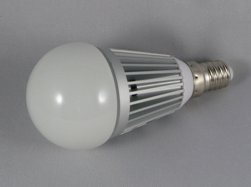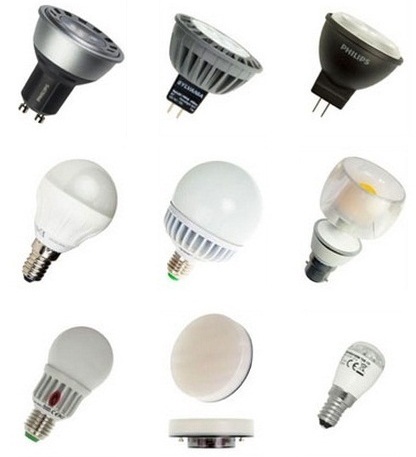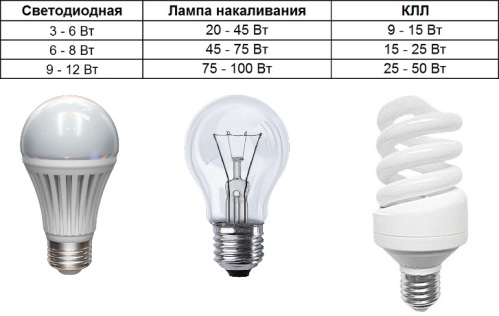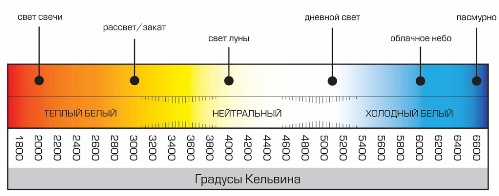Categories: Sources of light, Energy saving
Number of views: 36264
Comments on the article: 8
How to choose a LED lamp
 Progress does not stand still, and LED lamps are rapidly appearing on store shelves, gradually displacing not only incandescent lamps, but also compact fluorescent lamps, so beloved by many of those who are used to scrupulously approach energy conservation.
Progress does not stand still, and LED lamps are rapidly appearing on store shelves, gradually displacing not only incandescent lamps, but also compact fluorescent lamps, so beloved by many of those who are used to scrupulously approach energy conservation.
However compact fluorescent lamps (CFL) require special measures when disposing of them, so not everything went smoothly with them. The LED lamp, in turn, is environmentally completely safe. Comparison of different lamps in terms of light output see here: Comparison of the power of various types of lamps
Let's dwell in more detail on how to choose the right LED lamp, if necessary.
First of all, you should understand for yourself that it is not worth chasing cheapness when choosing an LED lamp, because a high-quality LED lamp can work for 50,000 hours. If you translate this into days, for example, 9 hours a day, you get more than 15 years. Therefore, the decision in favor of European manufacturers, which traditionally make very stringent requirements for both the quality of lighting and the reliability of products as a whole, will become quite reasonable.
You can be sure that the voltage converter built into the lamp base is assembled from high-quality components, in compliance with all measures for manufacturability and safety, which can not be said about cheap Chinese copies.


Now you need to determine which brightness required by LED lamp. For convenience, we present a table of data regarding the luminous flux of conventional incandescent lamps.

The corresponding luminous flux (measured in lumens), which gives a conventional incandescent lamp, is easily achieved by using an LED lamp, but the power consumed from the network will be 7-10 times lower.
To calculate the required power led lamp You can use the following table, which additionally provides data and for replacing compact fluorescent lamps (CFLs) with LED ones.

The next step is to select the lamp base. In modern lighting fixtures, flashlights and other lighting equipment, completely different lampholders are found, and the LED lamp bases are correspondingly different. It is important not to be mistaken, and choose a lamp with a suitable base. Here are the most common types of socles of modern LED lamps. Read more about this here: Types of lamp caps


An important property of LED lighting is the color temperature, measured in Kelvin. If you want to create a cozy lighting, comfortable for human perception, stop your choice on a warm shade. Warm (yellowish) light is much more comfortable for a person than cold. Cold light (closer to blue) is more suitable for lighting streets, car parks, and industrial premises.
For kitchens, bedrooms, and even for offices, warm lighting is recommended. If you mistakenly set a cold light in a living room, then its residents will become more irritable than they would be if they illuminated their homes with warm light.

The shape of the lamp for each application, for each specific purpose is selected individually. A candle-shaped lamp will create soft lighting, similar to how a candle’s flame illuminates a room, the heat from it is directed upward, and such a lamp is ideal for a decorative lamp. If directional lighting is required, a mirror lamp is suitable, and for greater similarity to a conventional bulb, a standard-shaped lamp.

Frosted or transparent lamp to choose? If the lamp is purchased for installation in a lamp where it will be hidden behind a patterned lampshade, or for installation in a closed lampshade, then a transparent lamp, that is, a lamp with a transparent bulb, is suitable.If you want to get the result of an aesthetic plan, then the matte lamp by itself will give more uniform lighting. If we talk about the quality of light, then it does not differ, the luminous flux from the opaque bulb does not suffer.

In dimmable lighting systems by dimmer switch, not every LED lamp will gradually change its brightness, as is usually the case with incandescent lamps. The feature of the built-in driver of a conventional LED lamp is that the lamp simply turns on at a certain dimmer position, and its brightness will be constant, no matter how you twist the dimmer to increase.
But for use with a dimmer, the so-called dimmable led bulbs, the driver in which is specially assembled so that when adjusting with a dimmer, the brightness of the LED lamp can be continuously adjusted.

Such lamps are somewhat more expensive than non-dimmable ones. Dimmable LED lamps are distinguished from ordinary ones by a special icon on the package.
See also at bgv.electricianexp.com
:

